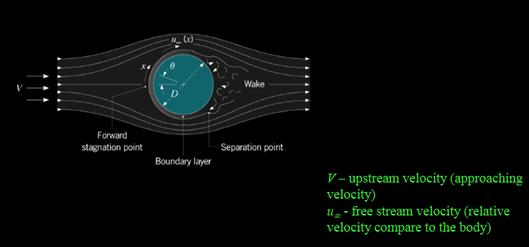
What is the difference between the upstream velocity and the free-stream velocity? For what types of flow are these two velocities equal to each other?
Difference between"Upstream flow velocity" and "free stream velocity"and for which flow are they equal.
Answer to Problem 1CP
Upstream velocity represents approaching velocity while free stream velocity represents velocity of fluid relative to the immersed body(solid).
They are equal in uniform flow.
The difference between upstream flow velocity and free stream velocity is given in table below:
| Upstream flow velocity | Free stream velocity |
| The velocity(V) at which any fluid flow approaches an immersed body is known as upstream flow velocity. | The sufficiently far away velocity of the fluid which is relative to the immersed body(solid) is the free stream velocity. It is denoted by |
| It is the actual velocity of fluid flowing just before approaching the immersed body | It is the velocity which exists at end of the velocity boundary layer around the immersed body. |

"Upstream flow velocity " and "free stream velocity" are same/equal when:
a. There is uniform fluid flow.
b. When the immersed body in fluid is relatively in comparison to uniform fluid flow rate, where it is immersed.
Explanation of Solution
The difference between upstream flow velocity and free stream velocity is given in table below:
| Upstream flow velocity | Free stream velocity |
| The velocity(V) at which any fluid flow approaches an immersed body is known as upstream flow velocity. | The sufficiently far away velocity of the fluid which is relative to the immersed body(solid) is the free stream velocity. It is denoted by |
| It is the actual velocity of fluid flowing just before approaching the immersed body | It is the velocity which exists at end of the velocity boundary layer around the immersed body. |

"Upstream flow velocity " and "free stream velocity" are same/equal when:
a. There is uniform fluid flow.
b. When the immersed body in fluid is relatively in comparison to uniform fluid flow rate, where it is immersed.
Want to see more full solutions like this?
Chapter 7 Solutions
HEAT&MASS TRANSF. (LL) W/CONNECT<CUSTOM>
Additional Engineering Textbook Solutions
Mechanics of Materials (10th Edition)
Starting Out with C++ from Control Structures to Objects (9th Edition)
Automotive Technology: Principles, Diagnosis, And Service (6th Edition) (halderman Automotive Series)
SURVEY OF OPERATING SYSTEMS
Starting Out with Java: From Control Structures through Objects (7th Edition) (What's New in Computer Science)
Vector Mechanics For Engineers
- Q5:(? Design the duct system of the figure below by using the balanced pressure method. The velocity in the duct attached to the AHU must not exceed 5m/s. The pressure loss for each diffuser is equal to 10Pa. 100CFM 100CFM 100CFM ☑ ☑ 40m AHU -16m- 8m- -12m- 57m 250CFM 40m -14m- 26m 36m ☑ 250CFMarrow_forwardA mass of ideal gas in a closed piston-cylinder system expands from 427 °C and 16 bar following the process law, pv1.36 = Constant (p times v to the power of 1.36 equals to a constant). For the gas, initial : final pressure ratio is 4:1 and the initial gas volume is 0.14 m³. The specific heat of the gas at constant pressure, Cp = 0.987 kJ/kg-K and the specific gas constant, R = 0.267 kJ/kg.K. Determine the change in total internal energy in the gas during the expansion. Enter your numerical answer in the answer box below in KILO JOULES (not in Joules) but do not enter the units. (There is no expected number of decimal points or significant figures).arrow_forwardmy ID# 016948724. Please solve this problem step by steparrow_forward
- My ID# 016948724 please find the forces for Fx=0: fy=0: fz=0: please help me to solve this problem step by steparrow_forwardMy ID# 016948724 please solve the proble step by step find the forces fx=o: fy=0; fz=0; and find shear moment and the bending moment diagran please draw the diagram for the shear and bending momentarrow_forwardMy ID#016948724. Please help me to find the moment of inertia lx ly are a please show to solve step by stepsarrow_forward
- My ID# 016948724arrow_forwardPlease do not use any AI tools to solve this question. I need a fully manual, step-by-step solution with clear explanations, as if it were done by a human tutor. No AI-generated responses, please.arrow_forwardPlease do not use any AI tools to solve this question. I need a fully manual, step-by-step solution with clear explanations, as if it were done by a human tutor. No AI-generated responses, please.arrow_forward
 Principles of Heat Transfer (Activate Learning wi...Mechanical EngineeringISBN:9781305387102Author:Kreith, Frank; Manglik, Raj M.Publisher:Cengage Learning
Principles of Heat Transfer (Activate Learning wi...Mechanical EngineeringISBN:9781305387102Author:Kreith, Frank; Manglik, Raj M.Publisher:Cengage Learning International Edition---engineering Mechanics: St...Mechanical EngineeringISBN:9781305501607Author:Andrew Pytel And Jaan KiusalaasPublisher:CENGAGE L
International Edition---engineering Mechanics: St...Mechanical EngineeringISBN:9781305501607Author:Andrew Pytel And Jaan KiusalaasPublisher:CENGAGE L Refrigeration and Air Conditioning Technology (Mi...Mechanical EngineeringISBN:9781305578296Author:John Tomczyk, Eugene Silberstein, Bill Whitman, Bill JohnsonPublisher:Cengage Learning
Refrigeration and Air Conditioning Technology (Mi...Mechanical EngineeringISBN:9781305578296Author:John Tomczyk, Eugene Silberstein, Bill Whitman, Bill JohnsonPublisher:Cengage Learning


